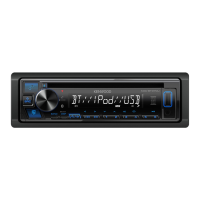What does “READING” keeps flashing mean on Kenwood KMR-D562BT?
- JjoshualinSep 12, 2025
If your Kenwood Car Receiver displays “READING” keeps flashing, do not use too many hierarchical levels or folders.

What does “READING” keeps flashing mean on Kenwood KMR-D562BT?
If your Kenwood Car Receiver displays “READING” keeps flashing, do not use too many hierarchical levels or folders.
What to do if Kenwood KMR-D562BT Car Receiver does not turn on?
If your Kenwood Car Receiver does not turn on, try resetting the unit.
What to do if my Kenwood Car Receiver says 'PLEASE EJECT'?
If your Kenwood Car Receiver displays 'PLEASE EJECT', try resetting the unit. If that doesn't work, consult your nearest service center.
What does 'CHECK ANTENNA' mean on my Kenwood Car Receiver?
If your Kenwood Car Receiver displays 'CHECK ANTENNA', check the antenna and its connection to ensure they are in good condition.
Why does my Kenwood KMR-D562BT Car Receiver say 'NO SIGNAL'?
If your Kenwood Car Receiver displays 'NO SIGNAL', make sure the antenna is mounted outside the vehicle.
What to do if disc cannot be ejected from Kenwood KMR-D562BT Car Receiver?
If a disc cannot be ejected from your Kenwood Car Receiver, press and hold M to forcibly eject the disc. If this does not solve the problem, reset the unit.
How to fix sound issues on Kenwood KMR-D562BT?
To address sound issues with your Kenwood Car Receiver: * Adjust the volume to the optimum level. * Check the cords and connections.
How to improve radio reception on Kenwood Car Receiver?
To improve poor radio reception on your Kenwood Car Receiver: * Connect the antenna firmly. * Pull the antenna out all the way.
What does 'CANNOT CREATE' mean on my Kenwood KMR-D562BT?
If your Kenwood Car Receiver displays 'CANNOT CREATE', it means that custom station name creation is unsuccessful.
What does 'STATION LIMIT' mean on my Kenwood KMR-D562BT?
If your Kenwood Car Receiver displays 'STATION LIMIT', retry after deleting unnecessary stations from your device.
| Category | Car Receiver |
|---|---|
| DIN Size | Single DIN |
| Bluetooth | Yes |
| USB Input | Yes |
| AUX Input | Yes |
| RMS Power Bandwidth | 20Hz - 20kHz |
| Display Type | LCD |
| Radio Tuner | AM/FM |
| SIRI Compatibility | Yes |
| Pandora Control | Yes |
| iHeartRadio Control | Yes |
| Spotify Control | Yes |
| Android Music Playback | Yes |
| iPhone Music Playback | Yes |
| FLAC Playback | Yes |
| Remote Control | Optional |
| Built-in Microphone | Yes |
| RMS Power Output | 22W |
| Peak Output | 50W |
| Preamp Voltage | 2.5 volts |
| Steering Wheel Control | Optional |
| Dimensions | 178mm x 50mm x 159mm |
| Compatible Formats | MP3, WMA, FLAC |
| Faceplate Security | Detachable Faceplate |
Important safety precautions for operating the unit while driving and general cautions.
Details about the remote control, its battery, and operational limitations.
Instructions for cleaning the unit, connectors, and handling discs.
Description of the unit's front panel, buttons, and basic operations.
Procedure for resetting the unit and its settings to default values.
Guide on how to use the remote control for basic functions and battery replacement.
Instructions on how to turn off the unit's demonstration mode.
Step-by-step guide to set the time, format, and display preferences.
Guide for initial system settings and configurations upon first use.
Methods for finding and storing radio stations, including direct access.
Using the remote control to tune directly to a specific radio frequency.
Adjustments for tuner settings, memory, mono, and traffic information.
How to begin playing media from CD, USB, iPod, or Android devices.
Controls for track, file, folder selection, repeat, and random play modes.
How to control iPod/iPhone and Android devices connected to the unit.
Setup, connection, and basic playback operations for Pandora.
Creating, saving, searching, and bookmarking Pandora stations.
Setup, connection, and basic playback operations for iHeartRadio.
Searching for stations, skipping cities, and deleting stations.
Connecting the SiriusXM tuner and activating the subscription.
How to start listening to SiriusXM and use direct tuning.
Using key modes, rewind/replay, and SmartFavorites features.
Adjusting various options for SiriusXM radio reception and features.
Receiving, rejecting, ending calls, and switching talk modes.
Adjusting microphone gain, noise reduction, and echo cancellation.
Configuring auto answer and battery/signal display.
Making calls using call history or the phonebook.
Manual dialing and using voice recognition for calls.
Deleting contacts and storing/calling from memory presets.
Device mode, PIN code, reconnect, auto-pairing, and initialization.
Checking Bluetooth device connectivity and profile compatibility.
Playing audio via Bluetooth and its playback controls.
Streaming Pandora and iHeartRadio through Bluetooth connection.
Adjusting equalization, bass, treble, and preset sound profiles.
Configuring subwoofer level, phase, HPF, fader, balance, and sound reconstruction.
Customizing display colors, brightness, and text scrolling behavior.
Details on supported CD, USB, and audio file formats.
Compatibility information for iPod, Android, Pandora, iHeartRadio, and Bluetooth.
Resolving common issues with sound, power, and radio reception.
Solutions for problems encountered with media playback from devices.
Specific troubleshooting steps for Android, Pandora, and iHeartRadio.
Resolving issues related to SiriusXM radio service and reception.
Addressing problems with Bluetooth connectivity, calls, and audio.
Technical details for tuner, CD player, and Bluetooth features.
Technical details for USB, audio output, and general unit specifications.
Important safety guidelines and precautions before installation.
Step-by-step instructions for installing the unit in the vehicle.
Diagrams and instructions for connecting the unit's wiring harness.
List of components included for the installation process.












